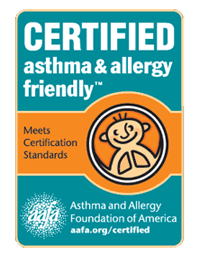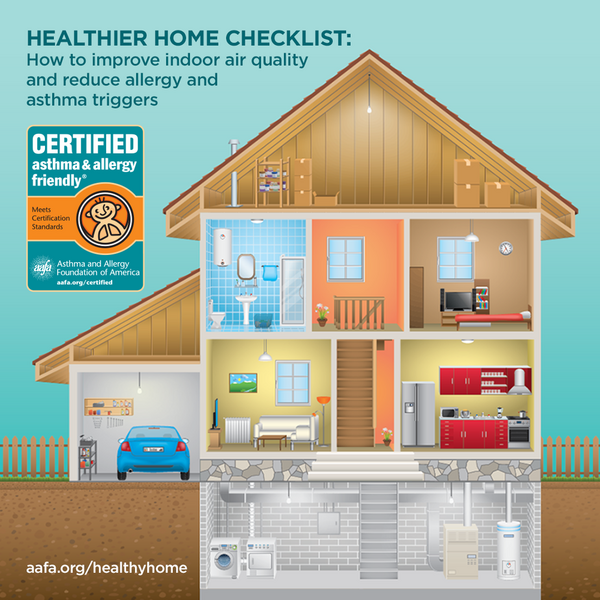Did you know people spend as much as 90% of their time inside their homes, offices, schools, and cars?1 For people with allergies and asthma, air quality is important both indoors and out.
What Impacts Your Indoor Air Quality?
Air quality is a measure of gases and small particles in the air that can be harmful to your lungs. Air pollution is when particles or gases that are not normally part of the air affect the air quality. Air pollution can happen indoors when items in your home release gases and irritants into the air. Outdoor air pollution (traffic exhaust, wildfire smoke, smog, etc.) can make its way in and get trapped inside to worsen your indoor air quality.
Allergens (like dust mites and pet dander) also impact your air quality. Allergens are the most common asthma trigger. This is called allergic asthma.

Some sources of indoor allergens include:
- Dust mites
- Pets
- Cockroaches and mice
- Mold and damp areas
- Wall-to-wall carpet
- Soft furniture and stuffed toys
- Mattresses
- Pillows and bedding
Some sources of indoor air pollution include:
- Scented household cleaners and air-fresheners
- Fuel-burning heat sources (such as gas stoves, cooktops, and fireplaces)
- Smoke from cooking, candles, fireplaces or cigarettes, cigars, pipes, and e-cigarettes (vapes)
- Vehicles or lawnmowers stored inside garages
- Fumes from new furniture and carpet
- Building and paint products
- Pesticides
- Radon and ozone
- Cosmetics, perfumes, and hair sprays
Having good indoor air quality is an important part of asthma and allergy management!
What Can You Do to Improve Indoor Air Quality?
The best way to improve indoor air quality is to:
- Remove sources of allergens and irritants.
- Improve ventilation with outdoor air.
- Filter your indoor air with good quality air filters on your central heating and air conditioning or portable air cleaners.
- Control indoor humidity.
Use our interactive Healthier Home Checklist to help you improve air quality in different areas of your home.
Here are a few tips:
![]() Establish regular cleaning routines using non-toxic and unscented cleaning products.
Establish regular cleaning routines using non-toxic and unscented cleaning products.
RELATED: Spring Cleaning for an Asthma and Allergy Friendly Home
![]() Remove fragranced products, candles, and air fresheners.
Remove fragranced products, candles, and air fresheners.
![]() Keep the humidity (moisture levels) in your home between 30-50%. Keeping humidity under 50% reduces growth of dust mites and mold. And keeping humidity above 30% prevents your skin, eyes, nose, and lips from drying out.
Keep the humidity (moisture levels) in your home between 30-50%. Keeping humidity under 50% reduces growth of dust mites and mold. And keeping humidity above 30% prevents your skin, eyes, nose, and lips from drying out.
![]() Replace carpets with solid surface flooring, if possible. Otherwise, vacuum carpets and rugs weekly.
Replace carpets with solid surface flooring, if possible. Otherwise, vacuum carpets and rugs weekly.
![]() Regularly clean and replace air filters according to instructions.
Regularly clean and replace air filters according to instructions.
![]() Quit smoking (including vaping) and don’t allow others to smoke in or around your home. If you live in a multi-family building like an apartment, close your windows if someone is smoking nearby. A portable air cleaner in your apartment may be helpful.
Quit smoking (including vaping) and don’t allow others to smoke in or around your home. If you live in a multi-family building like an apartment, close your windows if someone is smoking nearby. A portable air cleaner in your apartment may be helpful.
 Many products promise to help control allergens but not all of them do. When you are shopping for products for your home, look for the CERTIFIED asthma & allergy friendly® mark. It indicates the product has passed our testing standards to help reduce allergens and irritants in your home.
Many products promise to help control allergens but not all of them do. When you are shopping for products for your home, look for the CERTIFIED asthma & allergy friendly® mark. It indicates the product has passed our testing standards to help reduce allergens and irritants in your home.Visit aafa.org/certified to search for CERTIFIED products such as vacuums, air cleaners, cleaning products, flooring, bedding, appliances and more.
References
1. Indoor Air Quality. (2024, July 8). U.S. Environmental Protection Agency. https://www.epa.gov/report-env...t/indoor-air-quality




Comments (0)